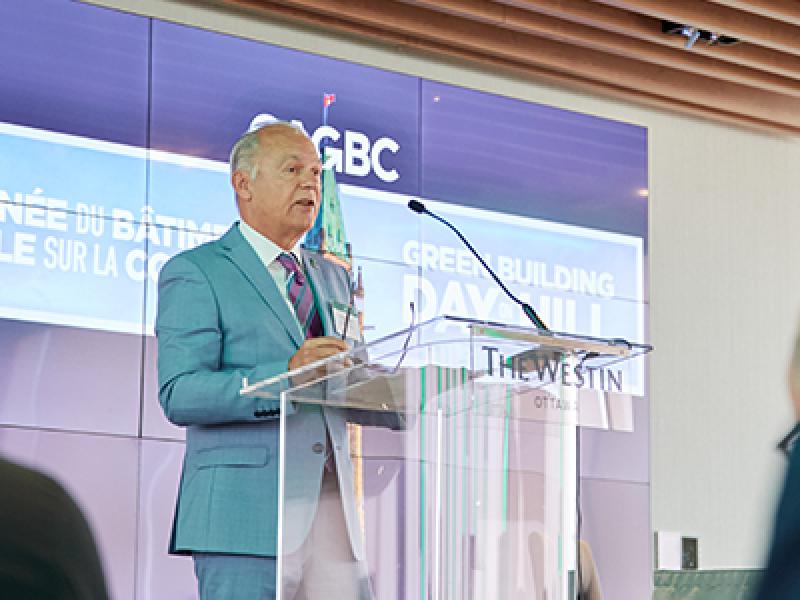
The boom times have ended, and industrial real estate owners and tenants across Ontario’s industrial heartland are in wait-and-see mode as vacancy rises and downward pressure increases on leasing rates.
The immediate question is how far the slowdown might go. But the mood was far from sombre during a deep dive into the industrial sector Thursday at the Southwestern Ontario Real Estate Forum at London’s RBC Place.
The region stretching south and west beyond the Greater Toronto Area has experienced record growth and leasing rate increases in recent years, so this levelling off was expected. Ongoing deliveries of modern, new space and uncertainty about the economy due to the trade war initiated by U.S. president Donald Trump are key contributors to the leasing pullback.
As an example, the Kitchener-Waterloo area has received “historic levels” of new space in the past few years. About half of that six million square feet (in a market of 65 million square feet) is now vacant, Colliers’ Southwest Ontario brokerage president Chris Kirwin said.
Other centres across the region have seen varying, but similar growth in their industrial inventories. Time is needed for that to be absorbed.
“Once we’ve got that fully absorbed and we are back to a normalized market, we can see growth again,” Ben Haythornthwaite, director of market analytics for the Greater Toronto Area at CoStar, said during the discussion.
Near future for industrial development land
He predicted that could take a year to 18 months, though in the meantime companies holding industrial development land could face some tough decisions - hold or try to sell, especially if they were planning to develop it quickly.
“For me it comes down to whether you are holding debt with your land,” he said. “If you are holding debt then it’s a very expensive thing to own. I think that is the big differentiator.”
On the leasing front, both Kimberley Hill of Toronto-based Dream Industrial, and Sean Ford of Dancor, which is headquartered in Brampton, said touring activity remains steady despite the new conditions. Both firms have significant holdings across the region.
“The competition is steep,” said Hill, Dream Industrial’s senior vice-president of customer solutions. She said potential tenants can now tour several properties rather than having to scramble to meet their space needs.
“We’re finding tenants are getting way more sophisticated. They know the market, they know what they want, they’re asking an awful lot more questions.”
"Pressure" on industrial leasing rates
They’re also asking for better rates and incentives.
“I think there is pressure on rates but I don’t think they are dropping significantly,” Hill said.
Ford echoed that thought: “We’ve seen rates come down, but deals are getting done.”
Tenants also know the balance of power has shifted in their favour. “They do know they have more control now. I think that’s a trend that’s not going to go away.”
JLL's Q1 2025 stats show vacancy at 5.2 per cent and just under 2.5 million square feet being developed across SW Ontario. Colliers' Q1 report cites 1.5 million square feet of absorption across the region over the previous 12 months.
The market is also somewhat bifurcated. While larger properties are seeing less leasing action, smaller industrial facilities are still in demand.
“We see that local deals on a smaller scale, under 50,000 (square feet), are happening just as they were last year and the year before,” Ford observed. “But, larger deals 150,000 (square feet) or more and . . . anybody that has got an American connection is going to wait and see what is going to happen.”
Dancor did just deliver a 660,000-square-foot distribution facility on Scanlan St., in London to retailer Gap Inc., but that deal was signed over a year ago. Offering 48-foot clear heights, it's part of an industrial area along the Veteran’s Memorial Parkway corridor leading to Highway 401.
“It kind of tells you London has arrived to build a building like this,” he said.
Dancor intends to keep its development land
He also said Dancor is going to keep its development land, and move forward with acquiring approvals so it can move quickly to develop. Spec building in the region has ceased, so he foresees a time in a year or two when space will again begin to tighten.
“We think 2026 is going to be a very good and happy year,” he said.
Another important note is that construction costs have eased in recent months. An overall slowdown in development means when someone wants to build, labour is available for the project.
“I think construction costs have really tapered off,” Hill said. “We just sent a bid out on an expansion here in London and we were surprised at how competitive everyone was … the numbers came in significantly below our budget.”
Ford suggested costs could be down as much as 10 per cent or more depending on the project and the trades involved. He said construction materials are also more readily available.
All in all both the region and the wider national industrial real estate sector remain healthy so far - despite the uncertain times.
“You can say that vacancy has quadrupled, but it’s still three per cent in a lot of the markets,” Haythornthwaite said. “If you look at Canada against other countries around the world, look at the U.S., we are about half their vacancy rate and we were growing rents about three times (the pace of) the U.S.
“Canada performed particularly well, the hottest bull run we’ve ever had in the country. So yes, we’re slowing from that but it’s far from a dead market.”










